Viennese Goulash (Wiener Saftgulasch) is a rich and flavorful stew featuring tender beef in a paprika-infused, onion-based sauce. This traditional Austrian dish is the perfect comfort food for any occasion.
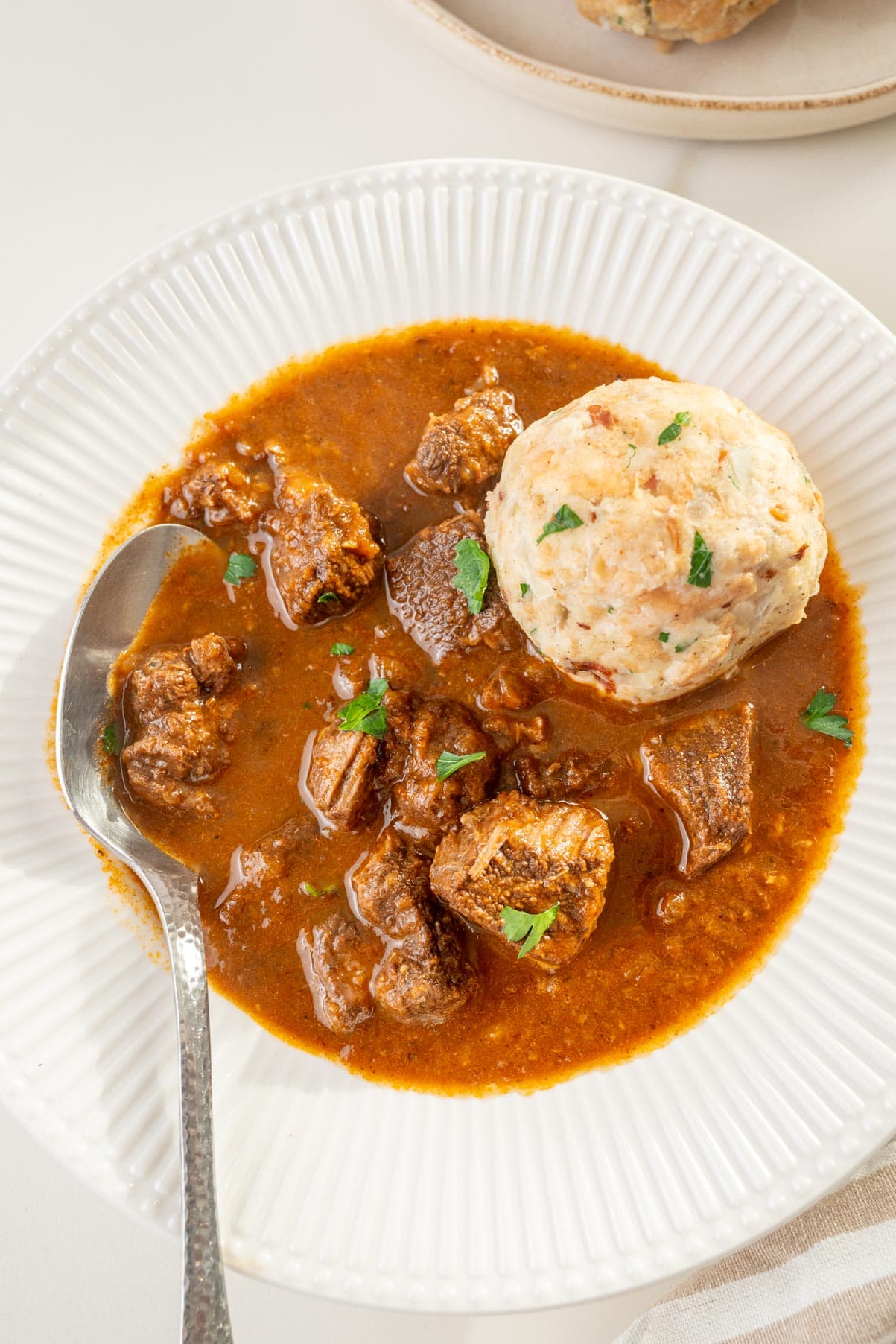
Ingredients
Here’s what you need to make this easy dish:
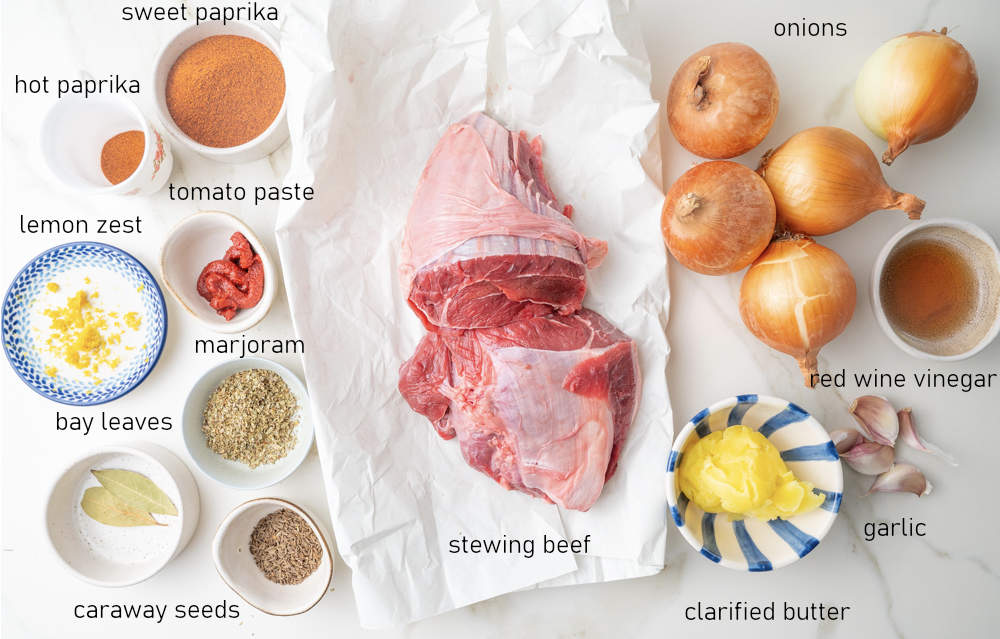
Beef – use stewing beef for this recipe, such as boneless beef shank, preferably from the rear legs of the cow. This cut of beef is traditionally used in Austria and is called Wadschinken. It’s known for its rich marbling and a substantial amount of connective tissue. This cut features a good amount of intramuscular fat, which renders down during slow cooking, imparting a deep flavor to the dish. This makes it ideal for long, slow braising, allowing the fat to melt and the connective tissue to break down, resulting in tender, succulent meat. Another option would be to use beef shoulder, but it’s much leaner, so you won’t get juicy pieces of meat like when using beef shank. The sauce will also be less thick, as there is less connective tissue in the meat to thicken the sauce.
Beef Broth or Water: For this recipe, it’s best to use high-quality beef broth, preferably homemade. If you don’t have any available, water is a suitable alternative. Many Austrian recipes recommend using water to enhance the pure beef flavor without introducing additional seasonings. Store-bought beef broth often doesn’t taste particularly good and it may ruin the dish.
Onions: yes, there are lots of onions in this recipe. They add flavor, sweetness, and thicken the sauce. Don’t try to add less, you need as much onions and meat, by weight (1:1 ratio). Traditionally, yellow onions are used. Although not traditional, I also tried this recipe using red onions, and it worked well.
Clarified butter – is a type of butter that is suitable for frying. It tastes just as good as regular butter but won’t burn easily. You can buy it store-bought or make homemade clarified butter, which is very quick and easy. Alternatively, you can use vegetable oil or a mix of vegetable oil with regular butter.
Paprika – a good quality, preferably Hungarian paprika is important in this recipe, we are adding a lot! You will need sweet (mild) paprika and hot (spicy) paprika.
Seasonings: Marjoram, Caraway seeds (don’t omit them, they add a characteristic flavor to the goulash), lemon zest (is optional).
Red wine vinegar – is absolutely needed to cut through the sweetness of the onions.
How to make it step-by-step
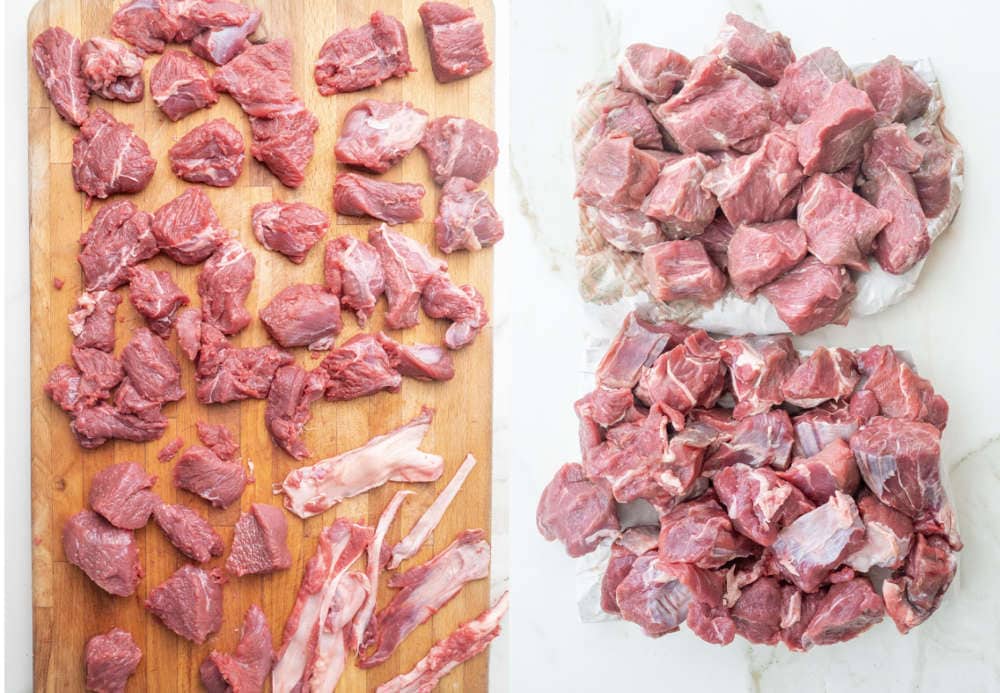
Prepare the meat: Cut the meat into large cubes (about 1 1/2 to 2 inches or 4-5 cm). If you see large, hard tendons, remove those, but don’t remove extra fat or smaller tendons in the meat (they will soften after long braising, and the fat will make the meat juicy). Season the meat well with salt and pepper on all sides. Set aside while you prepare the other ingredients and cook the onions.
2 pounds (900g) boneless beef shank
In the photo on the right, there are two types of meat shown: above is the beef shoulder, and below is the beef shank („Wadschinken”). You can clearly see the marbling and lots of connective tissue in the beef shank, while the shoulder is more lean. Beef shank, especially from the rear leg of the cow, is far better for this recipe.
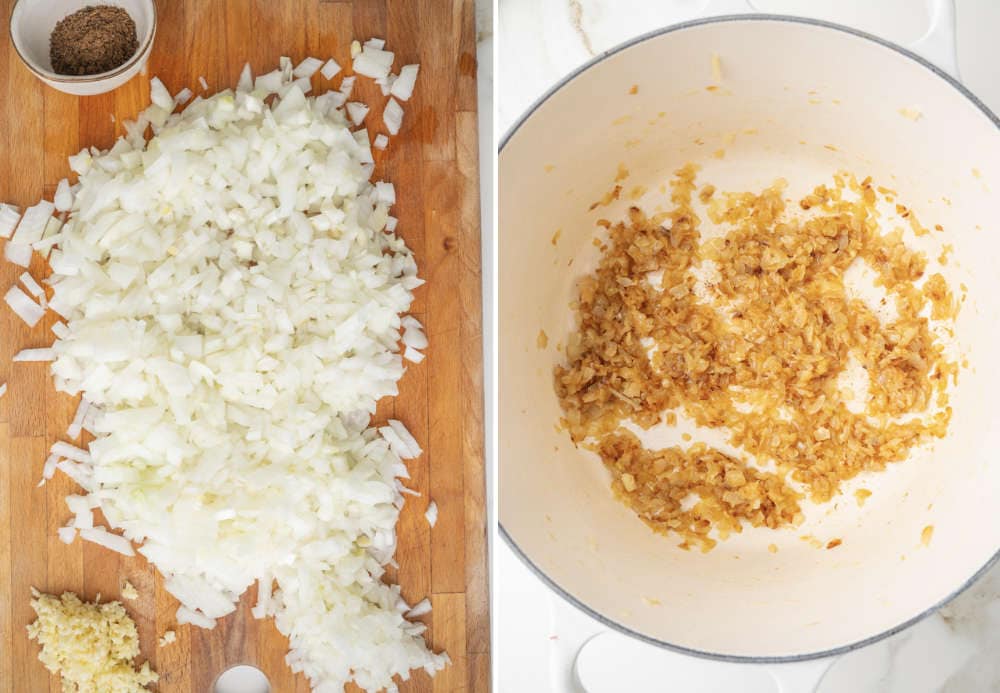
Prepare the remaining ingredients: Dice the onions and finely chop the garlic. Measure out the spices. Grind the caraway seeds (necessarily) and marjoram (not necessarily, but I prefer it) in a coffee/spice grinder or using a mortar and pestle.
(2 pounds (900g) onions, 4 cloves garlic, 3/4 tablespoon caraway seeds, 3/4 tablespoon marjoram, 3 tablespoons sweet paprika, 1 1/2 teaspoons hot/spicy paprika)
Cook onions: Heat clarified butter in a large pot (preferably a heavy-bottomed pot such as a Dutch oven). Add the onions and cook for 30 minutes until golden/ light brown in color. First, start over medium heat, stirring occasionally, then continue over medium heat, and finish over low heat, stirring frequently. Make sure not to burn the onions, or they will be bitter. If you see the onions are browning too fast, adjust/lower the heat.
(1/4 cup clarified butter (50g), or vegetable oil)
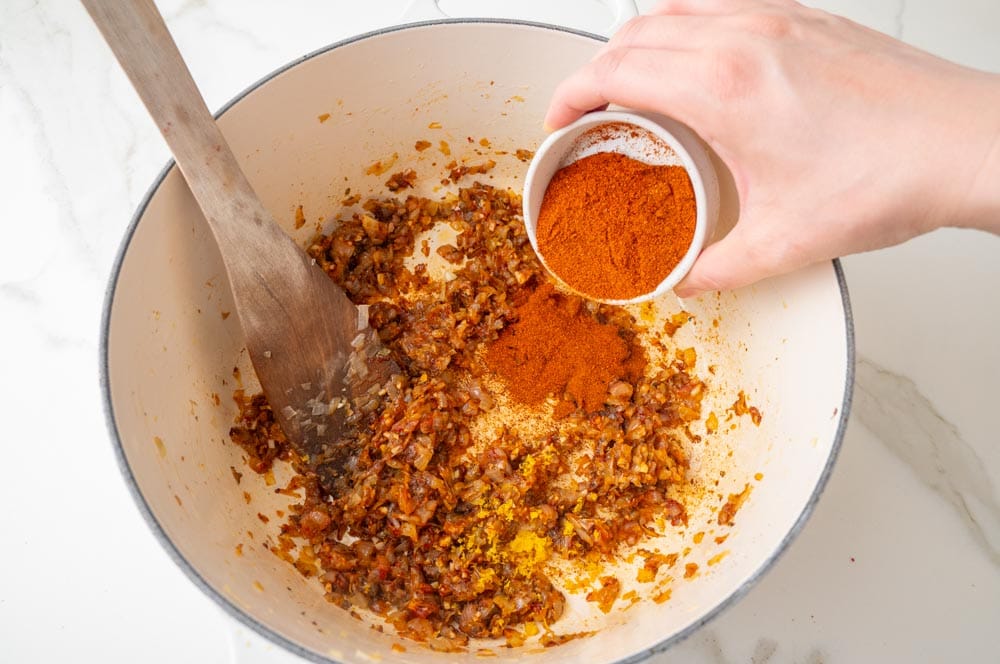
Cook goulash: Add garlic, caraway seeds, and marjoram, and cook over low heat for 1 minute.
Take the pot off the heat and add both types of paprika. Cook, stirring constantly, for no more than 20 seconds (if heated too much, it will be bitter).
Put the pot back on the heat and immediately add vinegar, lemon zest, and tomato paste. Stir to combine.
(zest grated from 1 lemon, 2 tablespoons red wine vinegar, 1 tablespoon tomato paste)
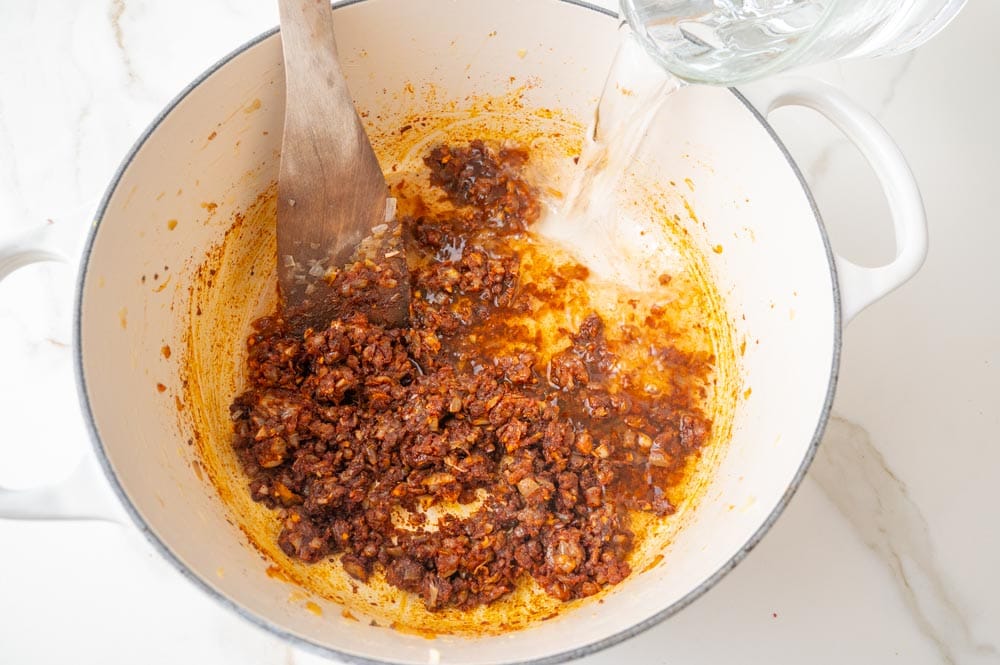
Add water or beef broth and bay leaves. Bring to a boil.
(2 cups (480ml) good-quality beef broth or water*, just enough liquid to cover the meat, 2 bay leaves)
At this point, if you wish, you could blend the sauce. This is not done traditionally because many Austrian recipes call for making goulash at least 1 day before serving it, and after this time, the onions almost dissolve into the sauce, achieving the perfect consistency. If you want to serve your goulash right away, you may want to blend the sauce slightly (not until smooth) with a hand/immersion blender.
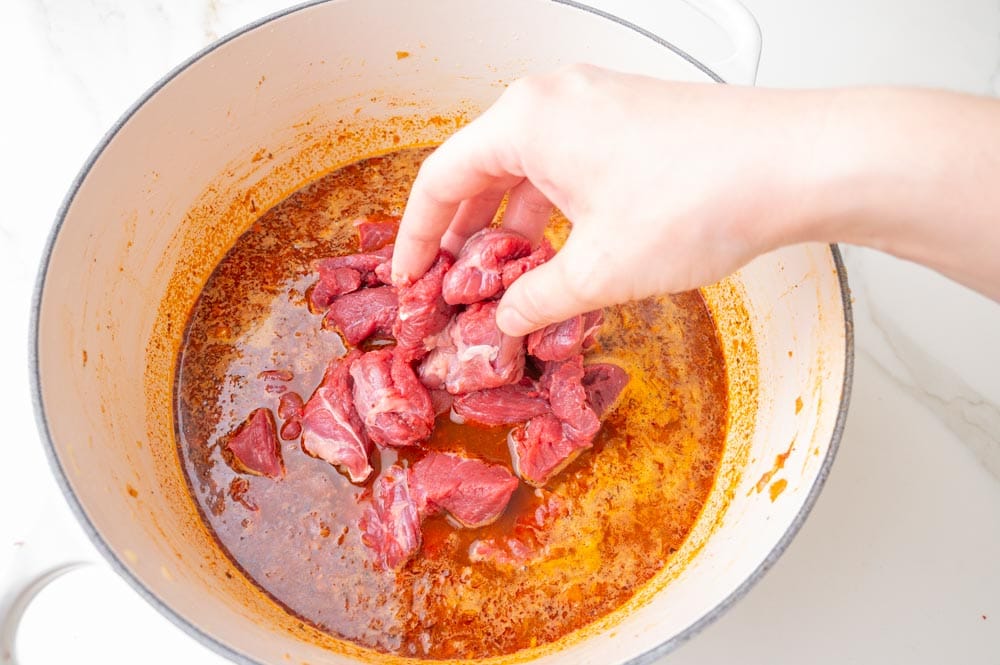
Reduce the heat to the lowest setting on your stove and add the meat. Yes, we are adding raw meat that has not been seared first. This is how this type of goulash is traditionally made, and it results in very tender beef. As you’re adding the meat, the liquid should cook very slowly; it should not boil rapidly. Close the pot with a lid completely (this is important). There is not a lot of liquid in the pot, and if you leave the pot open, the meat will come out tough.
The cooking time is 2-4 hours, depending on the type of beef cut you’ve used and the quality of the meat. I always cook my goulash for 3 hours. Very important – your goulash should not boil rapidly at any time, if should just barely simmer – you should see a couple of small bubbles at the surface of the goulash. The goulash will cook more rapidly when covered with a lid, so make sure to take that into account. Do not add any more salt at this point.
When the goulash is done cooking and the meat is tender, season it to taste with salt and pepper. Adjust the sweet and sour levels if necessary by adding more vinegar if the goulash is too sweet and a touch of sugar if it’s too sour.
Enjoy!
Serving suggestions
- The most popular way to serve Viennese goulash is with Kaisersemmeln – round bread rolls. Another popular side to this dish are Semmelknödel (bread dumplings).
- Kartoffelknödel (Kartoffelklöße) – potato dumplings
- Spätzle – thick, small-sized noodles
- Schupfnudeln – thick potato noodles, kind of like gnocchi
- Fiakergulash is a type of Viennese goulash that is served with Wieners/Frankfurters, sunny-side-up egg, and gherkins/pickles.
About the recipe
Traditional Austrian Goulash – A Viennese goulash is not like any other goulash recipe. There are a couple of things that may surprise you:
- There is no flour or any other thickening agent used; the sauce is thickened by a large amount of onions that almost blend into the sauce, and the natural collagen from the connective tissue of the meat. The cut of beef traditionally used in this recipe is rich in collagen/gelatin and fat. That’s why it’s so important to use a cut of beef that is rich in fat and connective tissue. If you use a lean cut of beef, there may not be enough connective tissue to achieve the proper consistency of the dish. The consistency of the stew may still be a little more runny than you are used to—this is how it should be. It’s even in the name of the goulash: Saftgulasch, which means 'Juice/Gravy Goulash.
- There are a lot of onions used in this recipe, the ratio is 1:1 onions to meat by weight!
- The meat is not seared before adding to the sauce, but it’s added raw and gently simmered in the sauce, resulting in a very tender texture. This is a traditional way to make this recipe.
- There is a lot of paprika added to the sauce!
- The recipe for Viennese goulash comes from Hungary, Austria’s neighboring country. But after some time, Austrians made this dish their own, and now you can truly say it’s a traditional Austrian recipe. Hungarian goulash is actually a meat and potato soup called gulyás, and a stew-like goulash is rather similar to a Hungarian dish called pörkölt, which is a meat and bell pepper stew. There are many differences between Austrian goulash and Hungarian goulash/soup: there are no bell peppers, a large amount of onions is added, the consistency is somewhere between a soup and a stew, and the goulash is always seasoned with caraway.
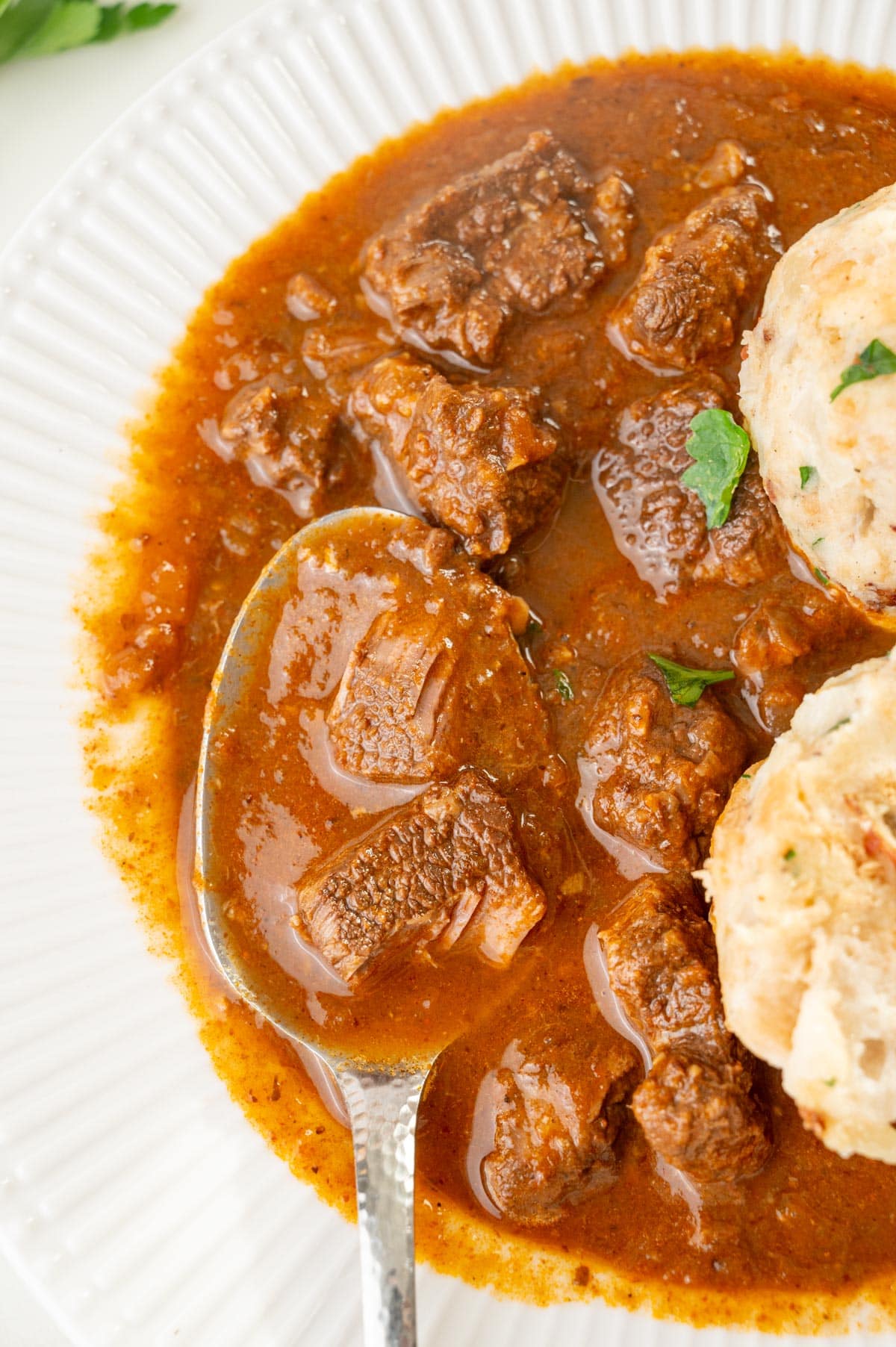
Did you make this recipe? RATE THE RECIPE or tell me in the COMMENTS how you liked it! You can also add a photo of your dish. It would make me very happy and will help other readers. Thank you!!
Viennese Goulash (Wiener Saftgulasch)
składniki
- 1/4 cup (50g) clarified butter or vegetable oil
- 2 pounds (900g) onions
- 4 cloves garlic
- 3/4 tablespoon caraway seeds
- 3/4 tablespoon marjoram
- 3 tablespoons sweet paprika
- 1 1/2 teaspoons hot/spicy paprika
- zest grated from 1 lemon
- 2 tablespoons red wine vinegar
- 1 tablespoon tomato paste
- 2 cups (480ml) good-quality beef broth or water just enough liquid to cover the meat
- 2 bay leaves
- 2 pounds (900g) boneless beef shank traditionally Wadschinken is used – a cut of beef that comes from the upper part of the rear leg of the cow
- salt and pepper to taste
Would you like to save this?
wykonanie
- Prepare the meat: Cut the meat into large cubes (about 1 1/2 to 2 inches or 4-5 cm). If you see large hard tendons, remove those, but don't remove extra fat or smaller tendons in the meat (they will soften after long braising and the fat will make the meat juicy). Season the meat well with salt and pepper on all sides. Set aside while you prepare the other ingredients and cook the onions.2 pounds (900g) boneless beef shank
- Prepare the remaining ingredients: Dice the onions and finely chop the garlic. Measure out the spices. Grind the caraway seeds (necessarily) and marjoram (not necessarily, but I prefer it) in a coffee/spice grinder or using a mortar and pestle.2 pounds (900g) onions, 4 cloves garlic, 3/4 tablespoon caraway seeds, 3/4 tablespoon marjoram, 3 tablespoons sweet paprika, 1 1/2 teaspoons hot/spicy paprika
- Cook onions: Heat clarified butter in a large pot (preferably a heavy-bottomed pot such as a Dutch oven). Add the onions and cook for 30 minutes until golden/ light brown in color. First, start over medium heat, stirring occasionally, then continue over medium heat, and finish over low heat, stirring frequently. Make sure not to burn the onions, or they will be bitter. If you see the onions are browning too fast, adjust/lower the heat.1/4 cup (50g) clarified butter
- Cook goulash: Add garlic, caraway seeds, and marjoram, and cook over low heat for 1 minute. Take the pot off the heat and add both types of paprika. Cook, stirring constantly, for no more than 20 seconds (if heated too much, it will be bitter).
- Put the pot back on the heat and immediately add vinegar, lemon zest, and tomato paste. Stir to combine. Add water or beef broth and bay leaves. Bring to a boil.zest grated from 1 lemon, 2 tablespoons red wine vinegar, 1 tablespoon tomato paste, 2 cups (480ml) good-quality beef broth or water, 2 bay leaves
- At this point, if you wish, you could blend the sauce. This is not done traditionally because many Austrian recipes call for making goulash at least 1 day before serving it, and after this time, the onions almost dissolve into the sauce, achieving the perfect consistency. If you want to serve your goulash right away, you may want to blend the sauce slightly (not until smooth) with a hand/immersion blender.
- Reduce the heat to the lowest setting on your stove and add the meat. Yes, we are adding raw meat that has not been seared first. This is how this type of goulash is traditionally made, and it results in very tender beef. As you’re adding the meat, the liquid should cook very slowly; it should not boil rapidly. Close the pot with a lid completely (this is important). There is not a lot of liquid in the pot, and if you leave the pot open, the meat will come out tough.
- The cooking time is 2-4 hours, depending on the type of beef cut you've used and the quality of the meat. I always cook my goulash for 3 hours. Very important – your goulash should not boil rapidly at any time, if should just barely simmer – you should see a couple of small bubbles at the surface of the goulash. The goulash will cook more rapidly when closed with a lid, so make sure to take that into account. Do not add any more salt and this point.
- When the goulash is done cooking and the meat is tender, season it to taste with salt and pepper. Adjust the sweet and sour levels if necessary by adding more vinegar if the goulash is too sweet and a touch of sugar if it’s too sour.
- Enjoy!
uwagi
- Please only use good-quality beef broth, preferably homemade, for this recipe. If you don’t have that on hand, just use water. Many Austrian recipes call for using water in this recipe to enhance pure beef flavor without too much of other flavorings. Store-bought beef broth often doesn’t taste particularly good and may ruin the dish.
- If you’re not cooking the onions for the whole 30 minutes, they won’t be as sweet, so it will be better to add less vinegar at the beginning, you can always add more at the end.
- Please don’t try to use fewer onions; they add sweetness and flavor to the goulash, and their amount contributes to the consistency of the sauce. The ratio of meat to onions is 1:1 by weight!
- Calories = 1 serving (1/6 of the recipe). This is only an estimate!

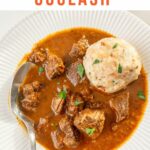
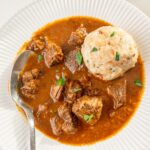
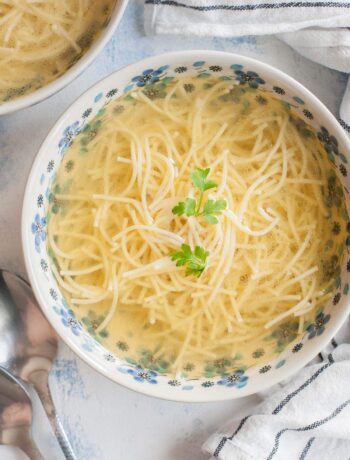

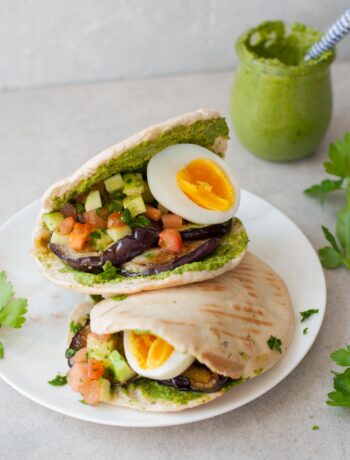
Brak komentarzy